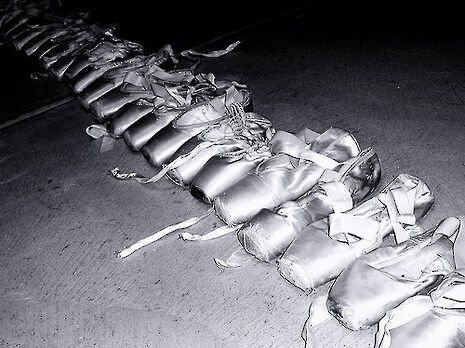Ballet: Triple Bill – Chroma/The Human Seasons/The Rite of Spring
Kizzie Burkett on the opportunities offered to students by the Royal Opera House

The Royal Opera House is working hard to break elitist stereotypes. Over the last few years, it has established a highly popular Student Scheme, offering students last-minute bargains, reserving a number of seats and standing spaces for each performance, and putting on five productions per year where the Amphitheatre is taken over by students. The latest Student Amphitheatre performance featured three ballets from the last half-century, which provided students with anything but the conventional image of the art form.
The most recent piece was The Human Seasons, a new work by former Royal Ballet School pupil David Dawson. Influenced by John Keats’ poem of the same title, it follows a year of seasons, emotions and human temperament. Far from the twee image the ‘seasons’ may provoke, Dawson’s work was subtle, modern and beautiful. The piece opened on a high – quite literally – as the curtain lifted to reveal first the shadows, and then the bodies of four motionless couples, the woman raised high above her partner’s head in an arabesque lift, before being plunged down into seemingly never-ending attitude promenades. This first section, representing spring, embodied a youthful joy and vitality, perfectly captured in Steven McRae’s show-stealing chaine turns.
If the rest of the work didn’t quite top this opening, it is not to say that the content or energy dwindled. It was a piece that never stopped moving, always offering something different and interesting to watch as the seasons overlapped and blurred into one. Dawson uses formations well. In one memorable section, eight dancers performed in overlapping, but separate duets, rotating in and out of each other in an ongoing cycle as steps and partners were recycled, changed and made their own, until one lost track of who and what was familiar. Later in the piece, the apparently weightless Melissa Hamilton was passed over, under and between six men, suddenly appearing in an unexpected location, held aloft by two men, or being spun around with her stomach skimming the floor, grasped only by one foot. There is nothing sinister or sensual about this section – perhaps it represents the idleness of autumn, or the mortality of winter. It is this very ambiguity that is so attractive in a work that one can completely get lost in.
Wayne McGregor’s highly acclaimed Chroma had a similar, modern aesthetic, yet I felt it lacked the depth and variety present in Dawson’s work. McGregor’s programme notes describe his desire to create a minimalistic dance space reduced to only its ‘essentials’, so as to make the movements and architecture of the body clear. The space and shapes created by the body are an evident focus throughout the work. The dancers beautifully juxtapose sharp, staccato movements with soft ripples and unbelievable extensions, the conflicting steps merging but always remaining distinct. Even when the music changes from a futuristic clanging to something calmer, the dancers remain frantic, projecting in a new way. Even if some diversity of movement was missing, it was still refreshing to see The Royal Ballet dance in such a way to music inspired by The White Stripes – surely an eye opener for many students in the audience.
Breaking from the modern beauty and purity of line in the first two pieces, the Triple Bill culminated with something entirely different: Kenneth MacMillan’s Rite of Spring. Even to those unfamiliar with ballet, Rite’s infamous history since its first performance by Ballets Russes in 1913 is well known. Undeniably, its ritualistic story and movements are - quite simply - odd, yet it is also strangely intriguing. What provoked me was not so much the movements themselves, but their sheer uniformity, the moments of stillness, the lack of emotion. The piece begins with two diagonal lines of dancers lying on the floor, their feet flexed to the sky, completely motionless. In the centre is a circular clump, heads moving left, right, left, right, centre. Arms follow, appearing from nowhere as if suffocating, before another grasps it. These are small movements, but they are mesmerising, drawing the audience in to the ritual being performed.
This is not a typical ballet; it is ugly, deranged and lacking emotion, identity, humanity. It is the patterns made by the mass of dancers that stand out, as lines, circles and formations appear from nowhere, bodies always organised and ordered. Near the end, uniform lines are made by dancers lying on their backs, opening and closing their arms and legs robotically whilst Claudia Dean as the Chosen One hopped between them as if in a video game – one centimetre or millisecond out and she would have fallen. The twenty year-old corps de ballet member performed the iconic role with the freshness, naivety and boundless energy that only someone of this age can bring. It looks like the Royal Ballet has a very bright, modern future.
To find out more about the Royal Opera House’s Student Scheme, and to sign up for free, visit www.roh.org.uk/for/students and www.facebook.com/RoyalOperaHouseCambridge
 Features / Should I stay or should I go? Cambridge students and alumni reflect on how their memories stay with them15 December 2025
Features / Should I stay or should I go? Cambridge students and alumni reflect on how their memories stay with them15 December 2025 News / SU reluctantly registers controversial women’s soc18 December 2025
News / SU reluctantly registers controversial women’s soc18 December 2025 News / Dons warn PM about Vet School closure16 December 2025
News / Dons warn PM about Vet School closure16 December 2025 News / Cambridge study finds students learn better with notes than AI13 December 2025
News / Cambridge study finds students learn better with notes than AI13 December 2025 Comment / The magic of an eight-week term15 December 2025
Comment / The magic of an eight-week term15 December 2025








